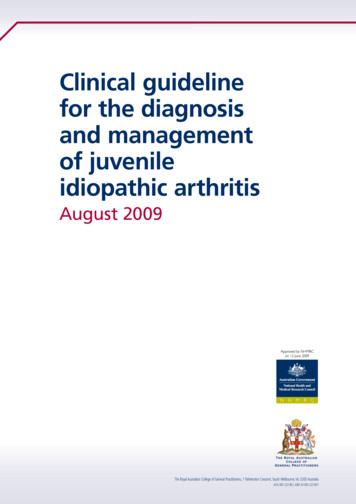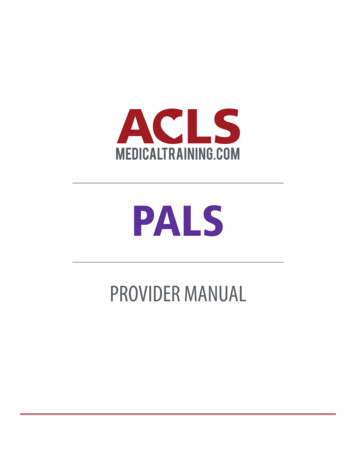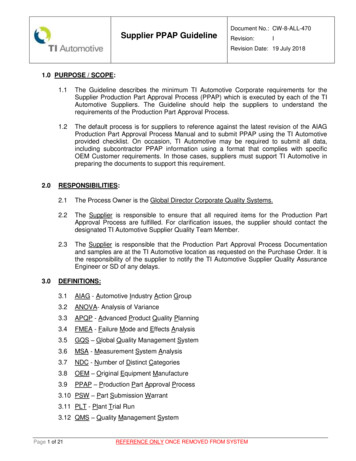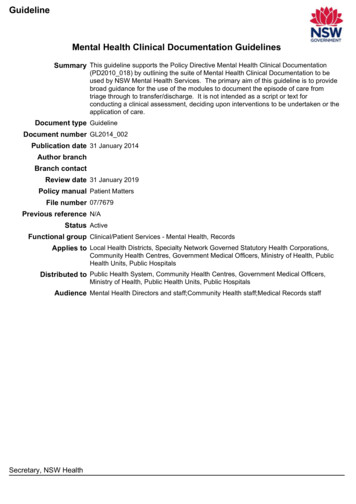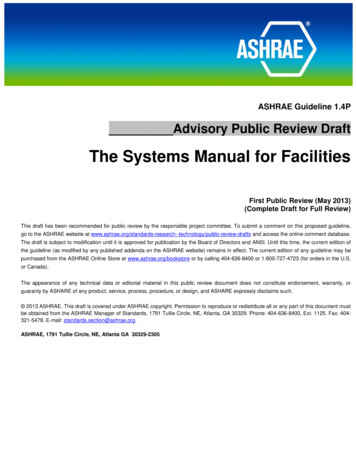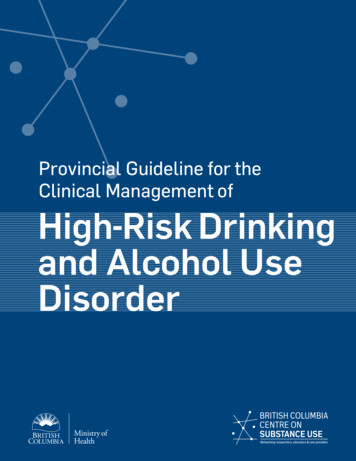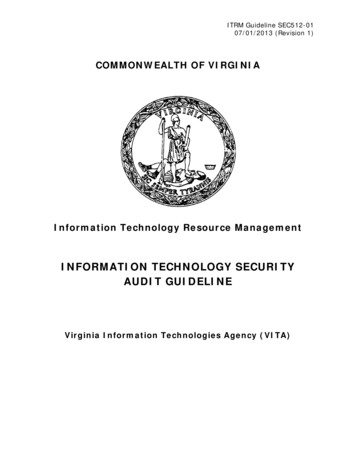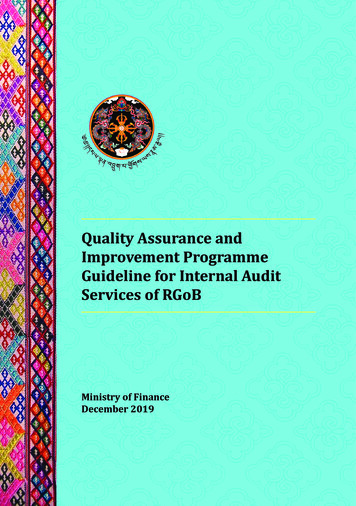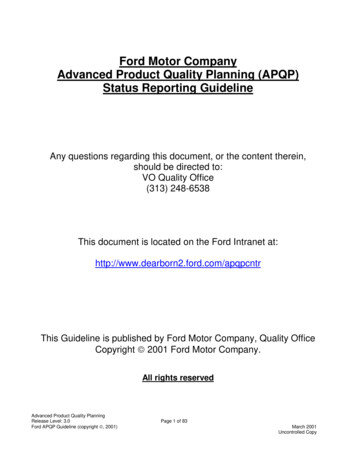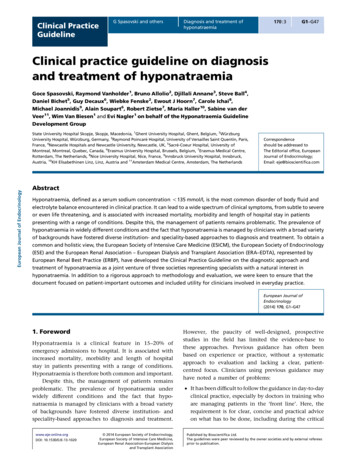
Transcription
Clinical PracticeGuidelineG Spasovski and othersDiagnosis and treatment ofhyponatraemia170:3G1–G47Clinical practice guideline on diagnosisand treatment of hyponatraemiaGoce Spasovski, Raymond Vanholder1, Bruno Allolio2, Djillali Annane3, Steve Ball4,Daniel Bichet5, Guy Decaux6, Wiebke Fenske2, Ewout J Hoorn7, Carole Ichai8,Michael Joannidis9, Alain Soupart6, Robert Zietse7, Maria Haller10, Sabine van derVeer11, Wim Van Biesen1 and Evi Nagler1 on behalf of the Hyponatraemia GuidelineDevelopment GroupEuropean Journal of EndocrinologyState University Hospital Skopje, Skopje, Macedonia, 1Ghent University Hospital, Ghent, Belgium, 2WürzburgUniversity Hospital, Würzburg, Germany, 3Raymond Poincaré Hospital, University of Versailles Saint Quentin, Paris,France, 4Newcastle Hospitals and Newcastle University, Newcastle, UK, 5Sacré-Coeur Hospital, University ofMontreal, Montreal, Quebec, Canada, 6Erasmus University Hospital, Brussels, Belgium, 7Erasmus Medical Centre,Rotterdam, The Netherlands, 8Nice University Hospital, Nice, France, 9Innsbruck University Hospital, Innsbruck,Austria, 10KH Elisabethinen Linz, Linz, Austria and 11Amsterdam Medical Centre, Amsterdam, The NetherlandsCorrespondenceshould be addressed toThe Editorial office, EuropeanJournal of Endocrinology;Email: eje@bioscientifica.comAbstractHyponatraemia, defined as a serum sodium concentration !135 mmol/l, is the most common disorder of body fluid andelectrolyte balance encountered in clinical practice. It can lead to a wide spectrum of clinical symptoms, from subtle to severeor even life threatening, and is associated with increased mortality, morbidity and length of hospital stay in patientspresenting with a range of conditions. Despite this, the management of patients remains problematic. The prevalence ofhyponatraemia in widely different conditions and the fact that hyponatraemia is managed by clinicians with a broad varietyof backgrounds have fostered diverse institution- and speciality-based approaches to diagnosis and treatment. To obtain acommon and holistic view, the European Society of Intensive Care Medicine (ESICM), the European Society of Endocrinology(ESE) and the European Renal Association – European Dialysis and Transplant Association (ERA–EDTA), represented byEuropean Renal Best Practice (ERBP), have developed the Clinical Practice Guideline on the diagnostic approach andtreatment of hyponatraemia as a joint venture of three societies representing specialists with a natural interest inhyponatraemia. In addition to a rigorous approach to methodology and evaluation, we were keen to ensure that thedocument focused on patient-important outcomes and included utility for clinicians involved in everyday practice.European Journal ofEndocrinology(2014) 170, G1–G471. ForewordHyponatraemia is a clinical feature in 15–20% ofemergency admissions to hospital. It is associated withincreased mortality, morbidity and length of hospitalstay in patients presenting with a range of conditions.Hyponatraemia is therefore both common and important.Despite this, the management of patients remainsproblematic. The prevalence of hyponatraemia underwidely different conditions and the fact that hyponatraemia is managed by clinicians with a broad varietyof backgrounds have fostered diverse institution- andspeciality-based approaches to diagnosis and treatment.www.eje-online.orgDOI: 10.1530/EJE-13-1020Ñ 2014 European Society of Endocrinology,European Society of Intensive Care Medicine,European Renal Association-European Dialysisand Transplant AssociationHowever, the paucity of well-designed, prospectivestudies in the field has limited the evidence-base tothese approaches. Previous guidance has often beenbased on experience or practice, without a systematicapproach to evaluation and lacking a clear, patientcentred focus. Clinicians using previous guidance mayhave noted a number of problems:† It has been difficult to follow the guidance in day-to-dayclinical practice, especially by doctors in training whoare managing patients in the ‘front line’. Here, therequirement is for clear, concise and practical adviceon what has to be done, including during the criticalPublished by Bioscientifica Ltd.The guidelines were peer reviewed by the owner societies and by external refereesprior to publication.
Clinical Practice Guideline††European Journal of Endocrinology††G Spasovski and others‘out-of-office hours’ period. Complex diagnostic algorithms and time-consuming investigations are realbarriers to implementation in this context.The guidance has been over-simplistic and does notreflect the range of clinical problems encountered inday-to-day practice.The guidance has been limited by a diagnosis-,mechanism- or duration-based approach to treatment,failing to recognise that establishing the diagnosis,mechanism or duration of hyponatraemia may bedifficult. Previous guidance has mostly used durationof hyponatraemia as a key point on which to basemanagement. Yet, duration can be hard to establish,especially in emergency settings. Decisions often haveto be made on limited information.The guidance has demonstrated an institutional orspecialty-specific bias, limiting implementation acrosssites and clinical disciplines. This is best demonstratedin institution- or speciality-specific approaches toinvestigations.The guidance has used a biochemical focus, failingto prioritise clinical status in decisions on treatmentoptions. Clinicians know that the degree of biochemicalhyponatraemia does not always match the clinical state ofthe patient. Guidance that bases management advicesimply on the serum sodium concentration may be counterto clinical experience, risking credibility and engagement.Together, these factors have limited the utility ofprevious advice. Two emerging themes require that werevisit the area:1. The clear recognition of the importance of evidence-basedapproaches to patient care to enhance quality, improvesafety and establish a clear and transparent frameworkfor service development and health care provision.2. The advent of new diagnostics and therapeutics, highlighting the need for a valid, reliable and transparentprocess of evaluation to support key decisions.To obtain a common and holistic view, the EuropeanSociety of Intensive Care Medicine (ESICM), the EuropeanSociety of Endocrinology (ESE) and the European RenalAssociation–European Dialysis and Transplant Association(ERA–EDTA), represented by European Renal Best Practice(ERBP), have developed new guidance on the diagnosticapproach and treatment of hyponatraemia. In addition toa rigorous approach to methodology and evaluation, wewere keen to ensure that the document focused onpatient-important outcomes and included utility forclinicians involved in everyday practice.www.eje-online.orgDiagnosis and treatment ofhyponatraemia170:3G22. Composition of the GuidelineDevelopment GroupA steering committee with representatives of all the threesocieties convened in October 2010 and decided on thecomposition of the Guideline Development Group, takinginto account the clinical and research expertise of eachproposed candidate.Guideline development group co-chairsGoce SpasovskiConsultant Nephrologist, State University HospitalSkopje, Skopje, Macedonia.Raymond VanholderConsultant Nephrologist, Ghent University Hospital,Ghent, Belgium.Work GroupBruno AllolioConsultant Endocrinologist, Würzburg University Hospital,Würzburg, Germany.Djillali AnnaneConsultant Intensivist, Raymond Poincaré Hospital,University of Versailles Saint Quentin, Paris, France.Steve BallConsultant Endocrinologist, Newcastle Hospitals andNewcastle University, Newcastle, UK.Daniel BichetConsultant Nephrologist, Hospital, Montreal, Canada.Guy DecauxConsultant Internal Medicine, Erasmus University Hospital,Brussels, Belgium.Wiebke FenskeConsultant Endocrinologist,Hospital, Würzburg, Germany.WürzburgUniversityEwout HoornConsultant Nephrologist, Erasmus Medical Centre,Rotterdam, The Netherlands.Carole IchaiConsultant Intensivist, Nice University Hospital, Nice,France.
Clinical Practice GuidelineG Spasovski and othersMichael JoannidisConsultant Intensivist, Innsbruck University Hospital,Innsbruck, Austria.Alain SoupartConsultant Internal Medicine, Erasmus University Hospital,Brussels, Belgium.Robert ZietseConsultant Nephrologist, Erasmus Medical Centre,Rotterdam, The Netherlands.ERBP methods support teamEuropean Journal of EndocrinologyMaria HallerSpecialist Registrar Nephrology, KH Elisabethinen Linz,Linz, Austria.Evi NaglerSpecialist Registrar Nephrology, Ghent University Hospital,Ghent, Belgium.Wim Van BiesenConsultant Nephrologist, Chair of ERBP, Ghent UniversityHospital, Belgium.Sabine van der VeerImplementation Specialist, Amsterdam Medical Centre,Amsterdam, The Netherlands.3. Purpose and scope of this guideline3.1. Why was this guideline produced?The purpose of this Clinical Practice Guideline was toprovide guidance on the diagnosis and treatment ofadult individuals with hypotonic hyponatraemia. It wasdesigned to provide information and assist in decisionmaking related to this topic. It was not intended to definea standard of care and should not be construed as one.It should not be interpreted as prescribing an exclusivecourse of management.This guideline was developed as a joint ventureof three societies representing specialists with a naturalinterest in hyponatraemia: the ESICM, the ESE and theERA–EDTA, represented by ERBP.All three societies agreed that there was a needfor guidance on diagnostic assessment and therapeuticmanagement of hyponatraemia. A recent systematicreview, which included three clinical practice guidelinesand five consensus statements, confirmed the lack ofDiagnosis and treatment ofhyponatraemia170:3G3high-quality guidelines in this field (1). The guidancedocuments scored low to moderate in the six domains ofthe AGREEII tool – scope and purpose, stakeholderinvolvement, rigour of development, clarity of presentation, applicability and editorial independence – and themanagement strategies proposed in the different guidancedocuments were sometimes contradictory (2).3.2. Who is this guideline for?This guideline was meant to support clinical decisionmaking for any health care professional dealing withhyponatraemia, i.e. general practitioners, internists, surgeons and other physicians dealing with hyponatraemiain both an outpatient and an in-hospital setting. Theguideline was also developed for policymakers for informing standards of care and for supporting the decisionmaking process.3.3. What is this guideline about?This section defines what this guideline intended to coverand what the guideline developers considered. The scopewas determined at a first meeting held in Barcelona inOctober 2010 with representatives of ESICM, ESE andERBP present.3.3.1. PopulationThe guideline covers hyponatraemia in adults throughthe biochemical analysis of a blood sample. It does notcover hyponatraemia detected in children because theguideline development group judged that hyponatraemiain children represented a specific area of expertise. Theguideline also does not cover screening for hyponatraemia.3.3.2. ConditionsThe guideline specifically covers diagnosis and managementof true hypotonic hyponatraemia. It covers the differentiation of hypotonic hyponatraemia from non-hypotonichyponatraemia but does not deal with the specific diagnostic and therapeutic peculiarities in the setting ofpseudohyponatraemia, isotonic or hypertonic hyponatraemia. These situations are not associated with the hypotonicstate responsible for the majority of symptoms attributableto true hypotonic hyponatraemia. The guideline coversdiagnosis and management of both acute and chronichypotonic hyponatraemia in case of reduced, normal andincreased extracellular fluid volume. It does not cover thediagnosis or treatment of the underlying conditions that canbe associated with hypotonic hyponatraemia.www.eje-online.org
Clinical Practice GuidelineG Spasovski and others3.3.3. Health care settingThis guideline targets primary, secondary and tertiarysettings dealing with diagnostic testing and the management of hyponatraemia in adults.3.3.4. Clinical managementThis guideline deals with diagnostic tools for improving accuracy of the differential diagnosis of hypotonic hyponatraemia, allowing more specific treatmentstrategies tailored to the underlying cause and/or pathophysiological mechanism.This guideline covers the treatment for adults withacute or chronic, symptomatic or asymptomatic hypotonichyponatraemia, regardless of the underlying condition.Diagnosis and treatment ofhyponatraemia170:3G42. In patients with hypotonic hyponatraemia, howaccurate are various ‘diagnostic strategies’ in comparison with a reference test of expert panel diagnosisin differentiating hypovolaemic from euvolaemichyponatraemia?4.2.2. Acute and chronic treatment of hypotonichyponatraemia1. In patients with hypotonic hyponatraemia, whichtreatments are effective in improving outcomes?2. In patients with hypotonic hyponatraemia, does thechange in serum sodium concentration per unit timeinfluence outcomes?4. Methods for guideline developmentEuropean Journal of Endocrinology4.1. Establishment of the guideline developmentgroupThe councils of the three participating societies, ESICM,ESE and ERBP, selected the co-chairs of the guidelinedevelopment group. The co-chairs then assembled thesteering committee with representatives of the threesocieties involved in this joint venture. This steeringcommittee convened in October 2010 and decided on thecomposition of the guideline development group, takinginto account the clinical and research expertise of theproposed candidates. The guideline development groupconsisted of content experts, which included individualswith expertise in hyponatraemia, endocrinology, generalinternal medicine, intensive care medicine and clinicalnephrology as well as an expert in systematic reviewmethodology. The ERBP methods support team providedmethodological input and practical assistance throughoutthe guideline development process.4.2. Developing clinical questionsFrom the final scope of the guideline, specific researchquestions, for which a systematic review would beconducted, were identified.4.2.1. Diagnosis and differential diagnosis of hypotonichyponatraemia1. In patients with hypotonic hyponatraemia, howaccurate are various ‘diagnostic strategies’ in comparisonwith a reference test of infusing 2 l 0.9% sodiumchloride solution for differentiating hypovolaemic fromeuvolaemic hyponatraemia?www.eje-online.org4.3. Development of review questionsThe methods support team assisted in developingreview questions, i.e. framing the clinical questionsinto a searchable format. This required careful specification of the patient group (P), the intervention (I),the comparator (C) and the outcomes (O) for intervention questions and the patient group, index tests,reference standard and target condition for questionsof diagnostic test accuracy (3). For each question, theguideline development group agreed on explicit reviewquestion criteria including study design features (SeeAppendices 1, 2 for Detailed Review Questions andPICO tables. See section on Appendix given at the endof this article).4.4. Assessment of the relative importance ofthe outcomesFor each intervention question, the guideline development group compiled a list of outcomes, reflectingboth benefits and harms of alternative managementstrategies. The guideline development group rankedthe outcomes as critically, highly or moderatelyimportant according to their relative importance in thedecision-making process. As such, patient-importanthealth outcomes related to hyponatraemia and thetreatment for hyponatraemia were considered critical.Owing to its surrogate nature, the outcomes ‘changein serum sodium concentration’ and ‘correction of serumsodium concentration’ were considered less importantthan the critically and highly important clinicaloutcomes (Table 1).
G Spasovski and othersClinical Practice GuidelineTable 1Hierarchy of outcomes.HierarchyOutcomesCritically importantPatient survivalComaBrain damage/brain oedemaEpileptic seizuresOsmotic demyelinatingsyndromeRespiratory arrestQuality of lifeCognitive functionBone fracturesFallsLength of hospital staySerum sodium concentrationHighly importantModerately importantEuropean Journal of Endocrinology4.5. Target population perspectivesAn effort was taken to capture the target population’sperspectives by adopting two strategies. First, ERBP hasa permanent patient representative in its board. Althoughhe was not included in the guideline development groupor in the evidence review process, drafts of the guidelinedocument were sent for his review and his comments weretaken into account in revising and drafting the finaldocument.Secondly, the guideline underwent public reviewbefore publication. The guideline was sent to the councilof two different societies for each specialty involved: forESICM, the Australian and New Zealand Intensive CareSociety (ANZICS) and American Society of Critical CareMedicine (SSCM); for ESE, the Endocrine Society ofAustralia (ESA) and the Endocrine Society (USA); and forERBP, the Kidney Health Australia–Caring for Australasians with Renal Impairment (KHA–CARI) and theAmerican Society of Nephrology (ASN). Each of thesesocieties was specifically asked to indicate two to threereviewers. Reviewers could use free text to suggestamendments and/or fill in a matrix questionnaire inMicrosoft Excel. All members of the ERA–EDTA receivedan online questionnaire with a standardised answer formin Microsoft Excel. ERA–EDTA members were asked toexpress to what extent they judged the individualstatements were clear and implementable and to whatextent they agreed with the content. In addition, a freetext field was provided to allow for additional comments.4.6. Searching for evidence4.6.1. SourcesThe ERBP methods support team searched The CochraneDatabase of Systematic Reviews (May 2011), DAREDiagnosis and treatment ofhyponatraemia170:3G5(May 2011), CENTRAL (May 2011) and MEDLINE (1946to May, week 4, 2011) for questions on both diagnosis andtreatment. To identify the limits for the increase in serumsodium concentration above which the risk of osmoticdemyelination starts to rise, we searched MEDLINEdatabase from 1997 onwards under the assumption thatearlier reports would describe more dramatic increasesand would not contribute to helping us set an upper limit.All searches were updated on 10th December 2012. Thesearch strategies combined subject headings and textwords for the patient population, index test and targetcondition for the diagnostic questions and subject headings and text words for the population and interventionfor the intervention questions. The detailed searchstrategies are available in Appendix 3, see section titledAppendix given at the end of this article.Reference lists from included publications werescreened to identify additional papers. The methodssupport team also searched guideline databases andorganisations including the National Guideline Clearinghouse, Guidelines International Network, GuidelinesFinder, Centre for Reviews and Dissemination, NationalInstitute for Clinical Excellence, and professional societiesof Nephrology, Endocrinology and Intensive CareMedicine for guidelines to screen the reference lists.4.6.2. SelectionFor diagnostic questions, we included every study thatcompared any of the predefined clinical or biochemicaltests with infusion of 2 l 0.9% saline as a reference test orwith an expert panel for differentiating hypovolaemicfrom euvolaemic hyponatraemia. For questions on treatment strategies, we included every study in which one ofthe predefined medications was evaluated in humans. Weexcluded case series that reported on benefit if the numberof participants was %5 but included even individual casereports if they reported an adverse event. No restrictionwas made based on language. For identifying the limitsfor the increase in serum sodium concentration abovewhich the risk of osmotic demyelination starts to rise,we included all observational studies reporting cases ofosmotic demyelinating syndrome and correspondingserum sodium concentration correction speeds.A member of the ERBP methods support teamscreened all titles and abstracts to discard the clearlyirrelevant ones. All members of the guideline development group completed a second screening. All abstractsthat did not meet the inclusion criteria were discarded.Any discrepancies at this stage were resolved by groupconsensus.www.eje-online.org
Clinical Practice GuidelineG Spasovski and othersEuropean Journal of EndocrinologyThe methods support team retrieved full texts ofpotentially relevant studies and two reviewers examinedthem for eligibility independently of each other. Thereviewer duos always consisted of one content specialistand one methodologist from the ERBP methods supportteam. Any discrepancies were resolved by consensus. Ifno consensus could be reached, the disagreement wassettled by group arbitrage.4.6.3. Data extraction and critical appraisal ofindividual studiesFor each included study, we collected relevant information on design, conduct and relevant results throughstandardised data extraction forms in Microsoft Excel(2010). As part of an ongoing process of introducingsoftware to facilitate the guideline development process,the ERBP methods support team used two formats fordata extraction and collation. For detailed methods,see Appendices 4, 5, see section titled Appendix givenat the end of this article. Briefly, we used both asimple spreadsheet format and a more sophisticatedversion, which incorporated user forms programmed inVisual Basic. For each question, two reviewers extractedall data independently of each other. We producedtables displaying the data extraction of both reviewers.Both reviewers checked all data independently of eachother. Any discrepancies were resolved by consensus andif no consensus could be reached, disagreements wereresolved by an independent referee. From these tables,we produced merged consensus evidence tables forinforming the recommendations. The evidence tables areavailable in Appendices 6, 7, see section titled Appendixgiven at the end of this article.Risk of bias of the included studies was evaluatedusing various validated checklists, as recommended bythe Cochrane Collaboration. These were AMSTAR forSystematic Reviews (4), the Cochrane Risk of Bias toolfor randomised controlled trials (5), the Newcastle Ottawascale for cohort and case–control studies (6) and QUADASfor diagnostic test accuracy studies (7). Data werecompiled centrally by the ERBP methods support team.4.6.4. Evidence profilesThe evidence for outcomes on therapeutic interventionsfrom included systematic reviews and randomisedcontrolled trials was presented using the ‘Grading ofRecommendations Assessment, Development and Evaluation (GRADE) toolbox’ developed by the internationalGRADE working group (http://www.gradeworkinggroup.org/). The evidence profiles include details of the qualitywww.eje-online.orgDiagnosis and treatment ofhyponatraemia170:3G6assessment as well as summary – pooled or unpooled –outcome data, an absolute measure of intervention effectwhen appropriate and the summary of quality of evidencefor each outcome. Evidence profiles were constructed bythe methods support team and reviewed and confirmedwith the rest of the guideline development group.Evidence profiles were constructed for research questionsaddressed by at least two randomised controlled trials.If the body of evidence for a particular comparison ofinterest consisted of only one randomised controlled trialor of solely observational data, the summary tablesprovided the final level of synthesis.4.7. Rating the quality of the evidence for eachoutcome across studiesIn accordance with GRADE, the guideline developmentgroup initially categorised the quality of the evidence foreach outcome as high if it originated predominantly fromrandomised controlled trials and low if it originated fromobservational data. We subsequently downgraded thequality of the evidence one or two levels if results fromindividual studies were at serious or very serious risk ofbias, there were serious inconsistencies in the resultsacross studies, the evidence was indirect, the data weresparse or imprecise or publication bias thought to belikely. If evidence arose from observational data, but effectsizes were large, there was evidence of a dose–responsegradient or all plausible confounding would either reducea demonstrated effect or suggest a spurious effect whenresults showed no effect, we would upgrade the quality ofthe evidence (Table 2). Uncontrolled case series and casereports automatically received downgrading from low tovery low level of evidence for risk of bias, so that no otherreasons for downgrading were marked. By repeating thisprocedure, we would obtain an overall quality of theevidence for each outcome and each intervention. For listof definitions, see Table 3.4.8. Formulating statements and gradingrecommendations4.8.1. RecommendationsAfter the summary tables were produced and evidenceprofiles had been prepared, revised and approved by theguideline development group, two full-weekend plenarymeetings were held in September 2012 and December2012 to formulate and grade the recommendations.Recommendations can be for or against a certainstrategy. The guideline development group drafted the
Clinical Practice GuidelineTable 2G Spasovski and othersDiagnosis and treatment ofhyponatraemia170:3G7Method of rating the quality of the evidence. Adapted from Balshem H, Helfand M, Schünemann HJ, Oxman AD, Kunz R,Brozek J, Vist GE, Falck-Ytter Y, Meerpohl J, Norris S, et al. GRADE guidelines: 3. Rating the quality of evidence. Journal of ClinicalEpidemiology 2011 64 401–406. (240)Step 1: starting gradeaccording to study designEuropean Journal of EndocrinologyRandomised trialsZhighObservational studiesZlowStep 2: lower ifStep 3: higher ifRisk of biasK1 SeriousK2 Very seriousInconsistencyK1 SeriousK2 Very seriousIndirectnessK1 SeriousK2 Very seriousImprecisionK1 SeriousK2 Very seriousPublication biasK1 LikelyK2 Very likelyLarge effectC1 LargeC2 Very largeDose–responseC1 Evidence of a gradientAll plausible confoundingC1 Would reduce ademonstrated effectC1 Would suggest a spuriouseffect when results show noeffectrecommendations based on their interpretation of theavailable evidence. Judgements around four key factorsdetermined the strength of a recommendation: thebalance between desirable and undesirable consequencesof alternative therapeutic or diagnostic strategies, thequality of the evidence, the variability in values andpreferences. We did not conduct formal decision or costanalysis. In accordance to GRADE, we classified thestrength of the recommendations as strong, coded ‘1’ orweak, coded ‘2’ (Table 4; Fig. 1) (8). Individual statementswere made and discussed in an attempt to reach groupconsensus. If we could not reach consensus, we held aformal open vote by show of hands. An arbitrary 80% hadto cast a positive vote for a statement to be accepted.Voting results and reasons for disagreement were specifiedin the rationale.4.8.2. Ungraded statements and advice for clinicalpracticeWe decided to use an additional category of ungradedstatements for areas where formal evidence was notsought and statements were based on common sense orexpert experience alone. They were termed ‘statement’to differentiate them from graded recommendationsand do not hold an indicator for the quality of theevidence. The ungraded statements were generally writtenas simple declarative statements but were not meant tobe stronger than level 1 or 2 recommendations.We also provided additional advice for clinicalpractice. The advice is not graded and is only forthe purpose of improving practical implementation.Step 4: determine final grade forquality of evidenceHigh (four plus: 4444)Moderate (three plus:444B)Low (two plus: 44BB)Very low (one plus: 4BBB)It contains some elaboration on one of the statements,clarifying how the statement can be implemented inclinical practice.4.8.3. Optimizing implementationRecommendations often fail to reach implementationin clinical practice partly because of their wording. As partof a research project to evaluate methods for improvingguideline development processes, we integrated theGuideLine Implementability Appraisal (GLIA) instrumentto optimise the wording of the recommendations (9). Thetool primarily enables structured evaluation of factorssuch as executability (is it clear from the statement exactlywhat to do) and decidability (exactly under whatconditions) of preliminary recommendations. In addition,the tool is designed to highlight other problems possiblyhindering implementation, e.g. recommendations beinginconsistent with clinicians’ existing beliefs or patients’expectations. The appraisal was done by a panel oftarget guideline users external to the guideline development group. Comments and remarks were communicatedto the guideline development group and used to helprefine the recommendations.4.9. Writing rationaleWe collated recommendations and ungraded statementsfor each of the clinical questions in separate sectionsstructured according to a specific format. Each questionresulted in one or more specific boxed statements. Withineach recommendation, the strength was indicated aswww.eje-online.org
Clinical Practice GuidelineTable 3G Spasovski and othersDiagnosis and treatment ofhyponatraemiaGrade for the overall quality of evidence. Adaptedfrom Guyatt GH, Oxman AD, Vist GE, Kunz R, Falck-Ytter Y,Alonso-Coello P, Schünemann HJ & GRADE Working Group.GRADE: an emerging consensus on rating quality of evidenceEuropean Journal of Endocrinologyand strength of recommendations. BMJ 2008 336 924–926. (8)GradeQuality levelDefinitionAHighWe are confident that thetrue effect
Dec 10, 2012 · European Journal of Endocrinology Clinical Practice Guideline G Spasovski and others Diagnosis and treatment of hyponatraemia 170:3 G1–G47 www.eje-online.org 2014 European Society of Endocrinology, European Society of Intensive Care Medicine, European Renal Association-European Dia

